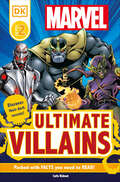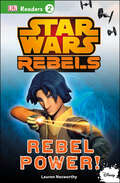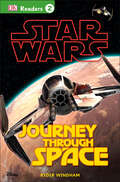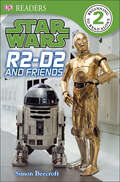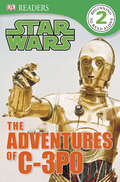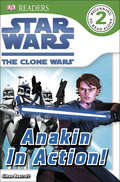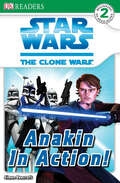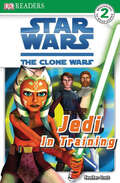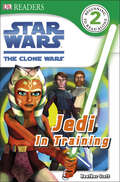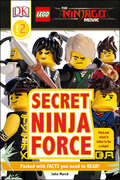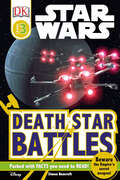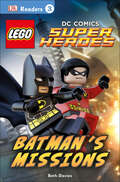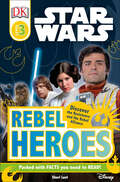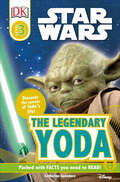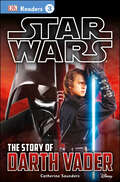- Table View
- List View
DK Readers L2: Marvel's Ultimate Villains (DK Readers Level 2)
by Cefn RidoutMeet the most terrifying villains in the Marvel Comics Universe including Thanos, Green Goblin, Ultron, Vulture, Red Skull, and more.This Reader features high-quality images from the Marvel comics. Packed with evil enemies and fearsome foes from the Marvel Comics Universe, discover their terrible plots and incredible powers. The mix of narrative spreads and interactive genre spreads encourages children to access information from a range of sources and develop comprehension skills.Perfect for 5- to 7-year-olds starting to read alone, Level 2 titles include in-depth information presented through more complex sentence structure with increasing amount of text to expand the reader's general knowledge and confidence in reading. Additional information spreads are full of extra facts, developing the topics through a range of nonfiction presentation styles, such as fliers, instructions, and record-breaker statistics.
DK Readers L2: Marvel's Ultimate Villains (DK Readers Level 2)
by Cefn RidoutMeet the most terrifying villains in the Marvel Comics Universe including Thanos, Green Goblin, Ultron, Vulture, Red Skull, and more.This Reader features high-quality images from the Marvel comics. Packed with evil enemies and fearsome foes from the Marvel Comics Universe, discover their terrible plots and incredible powers. The mix of narrative spreads and interactive genre spreads encourages children to access information from a range of sources and develop comprehension skills.Perfect for 5- to 7-year-olds starting to read alone, Level 2 titles include in-depth information presented through more complex sentence structure with increasing amount of text to expand the reader's general knowledge and confidence in reading. Additional information spreads are full of extra facts, developing the topics through a range of nonfiction presentation styles, such as fliers, instructions, and record-breaker statistics.
DK Readers L2: Star Wars Rebels: Rebel Power! (DK Readers Level 2)
by DKDiscover all there is to know about the heroes from the planet Lothal, including Ezra, Hera, and Chopper. © & TM 2015 LUCASFILM LTD.
DK Readers L2: Star Wars: Journey Through Space (DK Readers Level 2)
by Ryder WindhamIn DK's Level 2 Reader, Star Wars: Journey Through Space, readers are taken on an imaginary journey through the Star Wars galaxy, touching down on lots of wonderful planets from Revenge of the Sith and meeting some unusual characters along the way. With additional genre spreads added throughout, Star Wars: Journey Through Space introduces beginner readers to the Star Wars universe in a galaxy far, far away….
DK Readers L2: Star Wars: Journey Through Space (DK Readers Level 2)
by Ryder WindhamIn DK's Level 2 Reader, Star Wars: Journey Through Space, readers are taken on an imaginary journey through the Star Wars galaxy, touching down on lots of wonderful planets from Revenge of the Sith and meeting some unusual characters along the way. With additional genre spreads added throughout, Star Wars: Journey Through Space introduces beginner readers to the Star Wars universe in a galaxy far, far away….
DK Readers L2: Star Wars: R2-D2 and Friends (DK Readers Level 2)
by Simon BeecroftWith these new classic Star Wars(r) Readers, children learn about the fantastic Jedi Knights, rogue Rebels, heroic allies, and evil Sith Lords that are loved by several generations. R2-D2, C-3P0, and other droids, large and small, come to life in this classic Star Wars(r) reader. (c) 2008 Lucasfilm Ltd. (r) & TM
DK Readers L2: Star Wars: R2-D2 and Friends (DK Readers Level 2)
by Simon BeecroftWith these new classic Star Wars(r) Readers, children learn about the fantastic Jedi Knights, rogue Rebels, heroic allies, and evil Sith Lords that are loved by several generations. R2-D2, C-3P0, and other droids, large and small, come to life in this classic Star Wars(r) reader. (c) 2008 Lucasfilm Ltd. (r) & TM
DK Readers L2: Star Wars: The Adventures of C-3PO (DK Readers Level 2)
by Shari LastDK's Star Wars Readers are packed full of images, new information, familiar character poses, and fascinating facts to engage young fans. Imaginative heroes and villains and exciting adventure themes, combined with DK's nonfiction approach, encourage reluctant readers. In this all new Level 2 reader, children join the adventures of everyone's favorite droid C-3PO as he and his buddy R2-D2 travel the galaxy. With longer sentences and a simple index, beginner readers will have loads of fun learning about Star Wars while learning how to read in Star Wars: The Adventures of C-3PO.
DK Readers L2: Star Wars: The Clone Wars: Anakin in Action! (DK Readers Level 2)
by Simon BeecroftDK's Star Wars Readers help kids learn to read while enjoying the stories and characters from the blockbuster movies. In Anakin in Action!, fly into battle with Anakin Skywalker and join him on his adventures in the deadly Clone Wars. Packed with full-color photographs and engaging, age-appropriate stories, the ebooks introduce young children to a life-long love of reading. These amazing stories are guaranteed to capture children's interest while developing their reading skills. They're also perfect for reading together! The playful images in this ebook are enhanced with entertaining animations and surprising sounds to bring this story to life. © 2012 Lucasfilm Ltd.
DK Readers L2: Star Wars: The Clone Wars: Anakin in Action! (DK Readers Level 2)
by Simon BeecroftDK's Star Wars Readers help kids learn to read while enjoying the stories and characters from the blockbuster movies. In Anakin in Action!, fly into battle with Anakin Skywalker and join him on his adventures in the deadly Clone Wars. Packed with full-color photographs and engaging, age-appropriate stories, the ebooks introduce young children to a life-long love of reading. These amazing stories are guaranteed to capture children's interest while developing their reading skills. They're also perfect for reading together! © 2012 Lucasfilm Ltd.
DK Readers L2: Star Wars: The Clone Wars: Jedi in Training (DK Readers Level 2)
by Heather ScottInStar Wars: The Clone Wars Reader Level 2: Jedi In Training Anakin's new Padawan learner is young, brash...and a girl! But more than a match for any battle droids. © 2008 Lucasfilm Ltd. ® & TM
DK Readers L2: Star Wars: The Clone Wars: Jedi in Training (DK Readers Level 2)
by Heather ScottInStar Wars: The Clone Wars Reader Level 2: Jedi In Training Anakin's new Padawan learner is young, brash...and a girl! But more than a match for any battle droids. © 2008 Lucasfilm Ltd. ® & TM
DK Readers L2: Star Wars™: Lightsaber Battles (DK Readers Level 2)
by DKFind out about the mysterious Force that powers lightsabers, meet the Jedi and Sith who wield them, and discover the tactics needed to win in a deadly lightsaber duel.This book features amazing lightsaber clashes from across the entire movie saga as well as the popular animated TV series Star Wars: Rebels. It explores the adventures of Rey and Kylo Ren, Ezra and Kanan, Obi-Wan, Darth Vader, and more as they use their lightsabers in fierce battles. Take a closer look at lightsabers and their incredible powers in this fantastic Level 2 Reader. Perfect for 5- to 7-year-olds beginning to read fluently with support, Level 2 titles contain carefully selected photographic images to complement the text, providing strong visual clues to build vocabulary and confidence. Additional information spreads are full of extra fun facts, developing the topics through a range of nonfiction presentation styles such as diagrams and activities.
DK Readers L2: Star Wars™: Lightsaber Battles (DK Readers Level 2)
by DKFind out about the mysterious Force that powers lightsabers, meet the Jedi and Sith who wield them, and discover the tactics needed to win in a deadly lightsaber duel.This book features amazing lightsaber clashes from across the entire movie saga as well as the popular animated TV series Star Wars: Rebels. It explores the adventures of Rey and Kylo Ren, Ezra and Kanan, Obi-Wan, Darth Vader, and more as they use their lightsabers in fierce battles. Take a closer look at lightsabers and their incredible powers in this fantastic Level 2 Reader. Perfect for 5- to 7-year-olds beginning to read fluently with support, Level 2 titles contain carefully selected photographic images to complement the text, providing strong visual clues to build vocabulary and confidence. Additional information spreads are full of extra fun facts, developing the topics through a range of nonfiction presentation styles such as diagrams and activities.
DK Readers L2: The LEGO® NINJAGO® MOVIE™: Secret Ninja Force (DK Readers Level 2)
by DKJoin the Secret Ninja Force on their adventures!Meet the members of the Secret Ninja Force. Learn how they train with Master Wu and how they keep Ninjago City safe. Discover what happens when they work together. Find out what it takes to be a ninja.Level 2 is for children who have started to read alone, but still need some help. The books have more words than Level 1, slightly longer sentences that are still simple in construction, and slightly smaller type. Additional information spreads are full of extra fun facts and topic-related activities to make and do. The stories are slightly more complex than those in Level 1.THE LEGO NINJAGO MOVIE © & ™ Warner Bros. Entertainment Inc. & The LEGO Group. LEGO, the LEGO logo, the Minifigure, the Brick and Knob configurations and NINJAGO are trademarks and/or copyrights of the LEGO Group. ©2017 The LEGO Group. All rights reserved. (s17)
DK Readers L2: The LEGO® NINJAGO® MOVIE™: Secret Ninja Force (DK Readers Level 2)
by DKJoin the Secret Ninja Force on their adventures!Meet the members of the Secret Ninja Force. Learn how they train with Master Wu and how they keep Ninjago City safe. Discover what happens when they work together. Find out what it takes to be a ninja.Level 2 is for children who have started to read alone, but still need some help. The books have more words than Level 1, slightly longer sentences that are still simple in construction, and slightly smaller type. Additional information spreads are full of extra fun facts and topic-related activities to make and do. The stories are slightly more complex than those in Level 1.THE LEGO NINJAGO MOVIE © & ™ Warner Bros. Entertainment Inc. & The LEGO Group. LEGO, the LEGO logo, the Minifigure, the Brick and Knob configurations and NINJAGO are trademarks and/or copyrights of the LEGO Group. ©2017 The LEGO Group. All rights reserved. (s17)
DK Readers L3: Beware the Empire's Secret Weapon! (DK Readers Level 3)
by Simon Beecroft"That's no moon. It's a space station." The Death Star is one of the most feared weapons in the Empire's arsenal. Not only a weapon, the Death Star also houses Stormtroopers, Imperial Officers, and, of course, Darth Vader. Find out what it was like to live there and how the Death Star Was constructed and destroyed in Star Wars Readers Level 3: Inside the Death Star.
DK Readers L3: Can Batman and Robin Save Gotham City? (DK Readers Level 3)
by DKJoin Batman™ as he fights crime in Gotham City and beyond!Learn how Batman and Robin train to take on their enemies. Go on epic missions. Follow Batman under the sea and out of this world!Engaging topics and fun, interactive pages build reading skills in this Level 3 Reader – just right for children who are beginning to read on their own. A glossary and fun quiz at the end of the book help to develop vocabulary and reading comprehension skills. Each title in the DK Readers series is developed in consultation with leading literacy experts to help children build a lifelong love of reading.©2014 The LEGO Group. Copyright © 2014 DC Comics.
DK Readers L3: Can Batman and Robin Save Gotham City? (DK Readers Level 3)
by DKJoin Batman™ as he fights crime in Gotham City and beyond!Learn how Batman and Robin train to take on their enemies. Go on epic missions. Follow Batman under the sea and out of this world!Engaging topics and fun, interactive pages build reading skills in this Level 3 Reader – just right for children who are beginning to read on their own. A glossary and fun quiz at the end of the book help to develop vocabulary and reading comprehension skills. Each title in the DK Readers series is developed in consultation with leading literacy experts to help children build a lifelong love of reading.©2014 The LEGO Group. Copyright © 2014 DC Comics.
DK Readers L3: Discover the Resistance and the Rebel Alliance (DK Readers Level 3)
by Shari LastDK Readers L3: Star Wars™: Rebel Heroes combines DK's four-level reading scheme with the record-breaking Star Wars movies, helping kids learn how to read—and learn to love reading. Young readers will learn about the most daring rebels and members of the Resistance in the Star Wars galaxy, including Poe Dameron, Princess Leia, Rey, Han Solo, Luke Skywalker, Ezra Bridger, and more!Perfect for 7–9 year olds starting to read alone, Level 3 titles include in-depth information presented through more complex sentence structure with increasing amount of text to expand the reader's general knowledge and confidence in reading. Additional information spreads are full of extra facts, developing the topics through a range of nonfiction presentation styles, such as fliers, instructions, and record-breaker statistics.© & TM 2016 LUCASFILM LTD. Used Under Authorization.
DK Readers L3: Discover the Resistance and the Rebel Alliance (DK Readers Level 3)
by Shari LastDK Readers L3: Star Wars™: Rebel Heroes combines DK's four-level reading scheme with the record-breaking Star Wars movies, helping kids learn how to read—and learn to love reading. Young readers will learn about the most daring rebels and members of the Resistance in the Star Wars galaxy, including Poe Dameron, Princess Leia, Rey, Han Solo, Luke Skywalker, Ezra Bridger, and more!Perfect for 7–9 year olds starting to read alone, Level 3 titles include in-depth information presented through more complex sentence structure with increasing amount of text to expand the reader's general knowledge and confidence in reading. Additional information spreads are full of extra facts, developing the topics through a range of nonfiction presentation styles, such as fliers, instructions, and record-breaker statistics.© & TM 2016 LUCASFILM LTD. Used Under Authorization.
DK Readers L3: Discover the Secret of Yoda's Life! (DK Readers Level 3)
by Catherine SaundersIn DK Star Wars readers, stunning photographs combine with engaging age-appropriate stories, creating a multilevel reading program guaranteed to capture children's interest while developing their reading skills! DK Readers: Level 3: Star Wars: The Legendary Yoda Yoda, the legendary Jedi Master, is the focus of this exciting Level 3 DK reader. Inside, rich vocabulary and challenging sentence structure, as well as an alphabetical glossary and comprehensive index, will help fans learn more about the most wise and mysterious Jedi Master of them all.
DK Readers L3: Discover the Secret of Yoda's Life! (DK Readers Level 3)
by Catherine SaundersIn DK Star Wars readers, stunning photographs combine with engaging age-appropriate stories, creating a multilevel reading program guaranteed to capture children's interest while developing their reading skills! DK Readers: Level 3: Star Wars: The Legendary Yoda Yoda, the legendary Jedi Master, is the focus of this exciting Level 3 DK reader. Inside, rich vocabulary and challenging sentence structure, as well as an alphabetical glossary and comprehensive index, will help fans learn more about the most wise and mysterious Jedi Master of them all.
DK Readers L3: Discover the Secrets from Darth Vader's Past! (DK Readers Level 3)
by Catherine Saunders Tori KosaraThis reading book for kids covers all the information that you could ever want to know about Anakin Skywalker and his transition to the evil Darth Vader!Come to the Dark Side. If your child is Star Wars mad and a raging fan of this infamous villain, this is the Darth Vader book that will crush all others. It has tons of info, fun facts, pictures from the movies, blurbs, and even a super fun quiz. With a fresh new look and added content, DK Reader Level 3: Star Wars: The Story of Darth Vader follows the life of one of the greatest movie villains as he rises to power. With loads of pictures from the movies, this reading book for kids is a real delight for young Star Wars fans. Guaranteed to engage kids as they learn to read on their own, it contains great vocabulary building words throughout. Level 3 is for children starting to read on their own. The stories are exciting and captivating in order to develop the child's own desire to read. More text and more complex sentence structure are presented, with information spreads to help develop the reader's general knowledge. The choice of subject widens to match the broadening of children's experiences and interests.Follow, Discover, Uncover & Learn!Follow Anakin Skywalker as he races, fights, and flies across the galaxy - and learn what leads him to betray his friends and become a Sith! Uncover the mystery behind Darth Vader's evil helmet and discover the story of a talented young Jedi who turns to the Dark Side. The ultimate Star Wars book for any Darth Vader fan. What's inside? - All the info you could possibly hope for about our favorite fictional Sith Lord- Lots of pictures, blurbs, and a really cool quizLearn to read - then read to learn. This book is part of an exciting four level reading/educational book series for children, developing the habit of reading widely for both pleasure and information. These chapter books have a compelling main narrative to suit your child's reading ability. Each knowledge book is designed to develop your child's reading skills, fluency, grammar awareness, and comprehension in order to build confidence and engagement when reading.Engaging stories and fun interactive pages build reading skills. Developed in consultation with leading literacy experts, it helps children build a lifelong love of reading. Level 1 learning to read, level 2 beginning to read, level 3 beginning to read alone, level 4 reading alone.Look out for other great Star Wars themed level 3 titles such as Death Star Battles, LEGO Star Wars Return of the Jedi and Finn's Mission.© & TM 2015 LUCASFILM LTD.
DK Readers L3: Discover the Secrets from Darth Vader's Past! (DK Readers Level 3)
by Catherine Saunders Tori KosaraThis reading book for kids covers all the information that you could ever want to know about Anakin Skywalker and his transition to the evil Darth Vader!Come to the Dark Side. If your child is Star Wars mad and a raging fan of this infamous villain, this is the Darth Vader book that will crush all others. It has tons of info, fun facts, pictures from the movies, blurbs, and even a super fun quiz. With a fresh new look and added content, DK Reader Level 3: Star Wars: The Story of Darth Vader follows the life of one of the greatest movie villains as he rises to power. With loads of pictures from the movies, this reading book for kids is a real delight for young Star Wars fans. Guaranteed to engage kids as they learn to read on their own, it contains great vocabulary building words throughout. Level 3 is for children starting to read on their own. The stories are exciting and captivating in order to develop the child's own desire to read. More text and more complex sentence structure are presented, with information spreads to help develop the reader's general knowledge. The choice of subject widens to match the broadening of children's experiences and interests.Follow, Discover, Uncover & Learn!Follow Anakin Skywalker as he races, fights, and flies across the galaxy - and learn what leads him to betray his friends and become a Sith! Uncover the mystery behind Darth Vader's evil helmet and discover the story of a talented young Jedi who turns to the Dark Side. The ultimate Star Wars book for any Darth Vader fan. What's inside? - All the info you could possibly hope for about our favorite fictional Sith Lord- Lots of pictures, blurbs, and a really cool quizLearn to read - then read to learn. This book is part of an exciting four level reading/educational book series for children, developing the habit of reading widely for both pleasure and information. These chapter books have a compelling main narrative to suit your child's reading ability. Each knowledge book is designed to develop your child's reading skills, fluency, grammar awareness, and comprehension in order to build confidence and engagement when reading.Engaging stories and fun interactive pages build reading skills. Developed in consultation with leading literacy experts, it helps children build a lifelong love of reading. Level 1 learning to read, level 2 beginning to read, level 3 beginning to read alone, level 4 reading alone.Look out for other great Star Wars themed level 3 titles such as Death Star Battles, LEGO Star Wars Return of the Jedi and Finn's Mission.© & TM 2015 LUCASFILM LTD.
